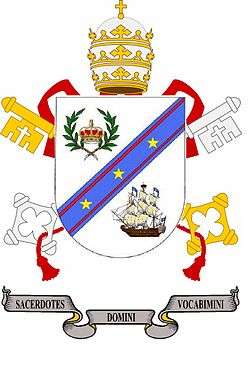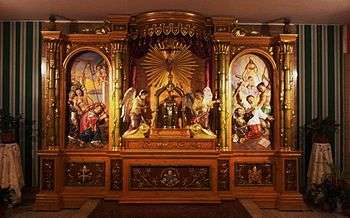Pontificio Collegio Filippino
| Dalubhasaang Pilipinong Pontipikal | |
 | |
| Latin: Collegium Pontificium Seminarium Sanctae Mariae de Pace et Bona Navigatione | |
| Motto | Sacerdotes Domini Vocabimini |
|---|---|
Motto in English | "...(ye) shall be named the Priests of the LORD..." (Isaiah 61:6) |
| Type | Roman Catholic Seminary; Continuing Formation Institute; Residence |
| Established | June 29, 1961 (55 years ago) |
| Rector | Rev. Fr. Gregory Ramon D. Gaston, S.T.D. |
| Location |
490 Via Aurelia, Rome, |
| Affiliations | Catholic Bishops' Conference of the Philippines |
| Website |
www |
Pontificio Collegio Filippino (English: Pontifical Filipino College; Filipino: Dalubhasaang Pilipinong Pontipikal), officially Pontificio Collegio Seminario de Nuestra Señora de la Paz y Buen Viaje (English: Pontifical College Seminary of Our Lady of Peace and Good Voyage), is the college of Filipino diocesan priests studying at pontifical universities in Rome, Italy. It was formally established as an institution with pontifical rights by Pope John XXIII on June 29, 1961 through the Papal Bull Sancta Mater Ecclesia.
The current rector of Pontificio Collegio Filippino is the Rev. Fr. Gregory Ramon D. Gaston, S.T.D.[1]
Building and some of its Unique Features
The seat of the institution is located at 490 Via Aurelia in the suburb of Rome where a four-story structure designed by Edoardo Cherubini and done in the contemporary architectural design of the 1960s stands on a 238,933.44 square metres (285,762.02 sq yd) property between the Collegio Pio-Brasiliano and the Villa Pacelli.
On the occasion of the canonization of St. Pedro Calungsod, the second Filipino saint, a commemorative Retablo was made by the Filipino sculptor Wilfredo Layug from Betis in Guagua, Pampanga,[2] for the Chapel at the crypt of the College.
Both "relleba" (relief murals) of the Retablo depict St. Lorenzo Ruiz and St. Pedro Calungsod, while being tortured by pagans, to force them to renounce their faith. St. Lorenzo Ruiz was executed in Nagasaki, Japan, in 1637; while St. Pedro Calungsod was killed together with Blessed Diego Luis de San Vitores in 1672 in Tumhon, Guam.[2]
In the mural of St. Pedro Calungsod, Layug carved the image of Our Lady of Peace and Good Voyage, the Patroness of the Pontificio Collegio Filippino. The angels are Filipina women garbed in baro and saya (native Filipino blouse and skirt), done in estofado, a detailed carving style that gives the image the look of real clothes.[2]
Bamboo is a constant motif in the Retablo.[2]
History
Cardinal Rufino Santos proposed establishing the college during the meeting of the Catholic Hierarchy of the Philippines on January 26–31, 1959. His plan was supported by the Philippine ecclesiastical hierarchy and approved by the Vatican.
On August 8, 1959, Pope John XXIII personally blessed the cornerstone for the building of Pontificio Collegio Filippino in the private study of his summer residence at Castel Gandolfo. Cardinal Rufino Santos, the Cardinal Archbishop of Manila, and Philippine Ambassador to the Holy See, Jose Ma. Delgado witnessed the significant event. The following day, Cardinal Giuseppe Pizzardo laid the cornerstone on the site of the edifice in the presence of 70 Cardinals, diplomats, Superiors General, seminary and university rectors and other distinguished personalities.[3] Pope John XXIII blessed and inaugurated the modern edifice on October 7, 1961 at the Feast of Our Lady of the Most Holy Rosary.[4]
References
- ↑ Vatican picks new Filipino college rector, www.ucanews.com
- 1 2 3 4 http://calungsod.cdn.ph/rome-tableau-shows-images-of-filipino-saints.html
- ↑ A document deposited in the cornerstone testifies that His Eminence, Giuseppe Cardinal Pizzardo, suburban Bishop of Albano and prefect of the Sacred Congregation for Seminaries and Universities, solemnly laid the cornerstone of the new College-Seminary, dedicated to Our Lady of Peace and Good Voyage, destined to welcome the Filipino young men who, endowed with science and strong faith, under the shadows of Peter and the tombs of the Martyrs, will one day go back to their country to diffuse this treasury of faith to those under their care.Cf. Pontificio Collegio Filippino, www.rc.net
- ↑ Pope John XXIII spoke of the mission of Pontificio Collegio Filippino during the inauguration saying: This Pontifical Seminary therefore is both a Roman and Philippine College; for here, that is, near the Chair of Peter and the summit of the Church, your young ones divinely called to take on sacred functions, will draw faith and science from the genuine and rich font. Fully imbued with this they shall return to their people as beloved heralds of truth. That is why these buildings destined for the formation of your students of sacred sciences will be like channels by which the catholic life will be promoted among you and the bond by which the Philippines, a Nation so very dear to us, will more intensely be linked with the supreme magisterium of the Church. Cf. Ibid.
External links
Coordinates: 41°53′50″N 12°25′16″E / 41.89722°N 12.42111°E

